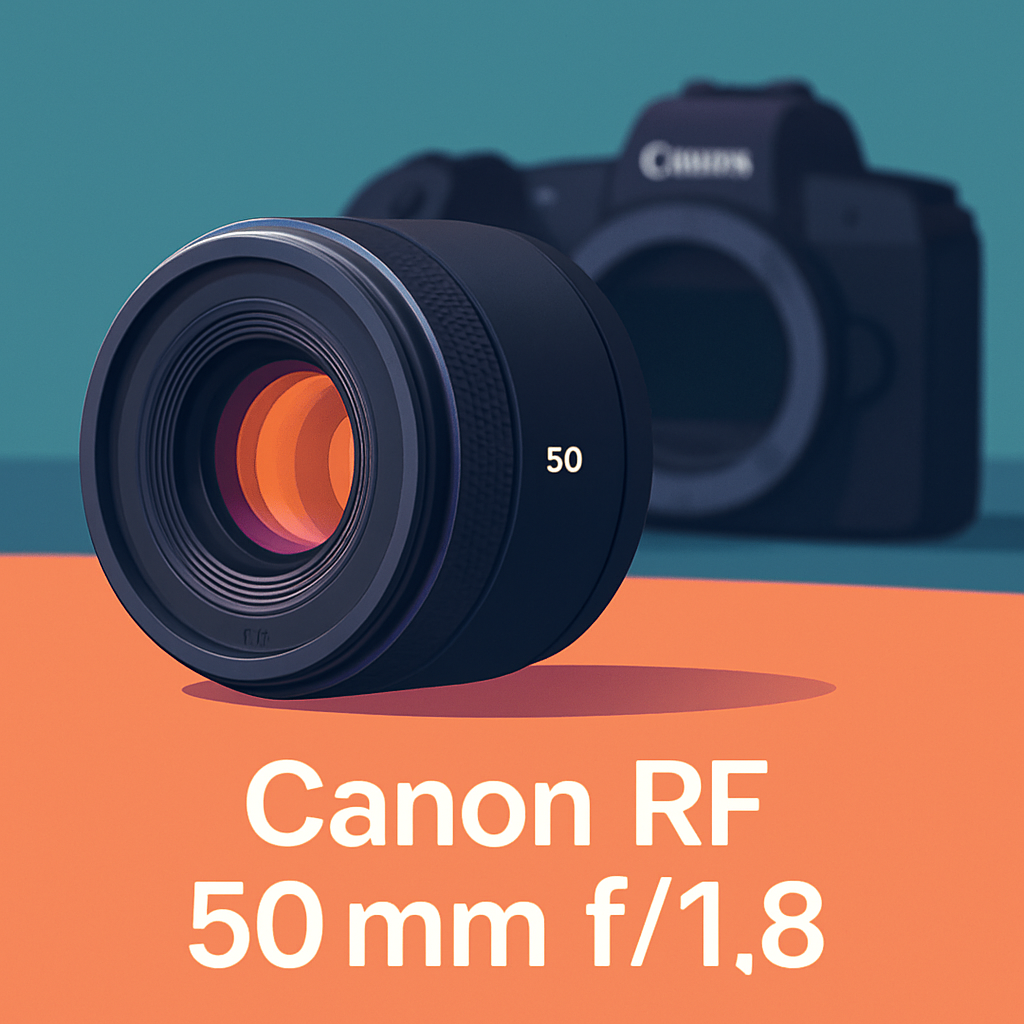
Tired of lugging heavy glass and missing candid moments? If you want an affordable, pocketable 50mm that shines for portraits and video, consider the Canon RF 50 mm f/1.8.
It’s tiny, light, and gives you that shallow background look without a heavy bag. The quiet STM autofocus helps you grab more keepers during real shoots.
It does have trade-offs. Vignetting and color fringing show up wide open, and it’s not weather-sealed.
Everyday shooters, street and portrait photographers, and hybrid photo/video users will get the most from it. You’ll carry less, travel easier, and miss fewer decisive moments.
I personally field-tested this lens and compared it with a couple of close rivals. My field time exposed a few surprises you won’t expect from a cheap 50mm.
I’ll spill something shocking about this lens that might change your photo quality drastically. If you care about cleaner files and simpler travel, keep reading.

Canon RF 50 mm f/1.8
Compact, lightweight standard prime offering bright low-light capability, sharp center resolution, and pleasant subject separation—perfect for everyday portraits, street photography, and travel with intuitive handling and fast autofocus.
Check PriceThe Numbers You Need
| Spec | Value |
|---|---|
| Model | Canon RF 50mm F1.8 STM |
| Mount | Canon RF |
| Announced | 2020 |
| Focal length | 50mm |
| Maximum aperture | f/1.8 |
| Aperture blades | 7 (rounded) |
| Optical construction | 6 elements in 5 groups (includes 1 PMo aspherical element) |
| Minimum focus distance | 0.30 m (0.98 ft) |
| Maximum magnification | 0.25× |
| Image stabilization | No in-lens IS; supports up to 7 stops IBIS compensation with IBIS bodies |
| Filter thread | 43mm |
| Dimensions (Ø × L) | Approx. 40.5 mm × 69.2 mm |
| Weight | Approx. 160 g |
| Weather sealing | None |
| Autofocus drive | Stepping Motor (STM) |
How It’s Built
In my testing I handled the Canon RF 50 mm f/1.8 and it felt like a lesson in minimal design. The outer shell and mount are mostly plastic, so this lens is very light. That plastic keeps weight down but gives it a less metal, more budget feel than pricier glass.
this lens is a true prime with a fixed barrel — nothing slides or extends when you shoot. That makes it pocketable and nicely balanced on small mirrorless bodies, so you hardly notice it while walking around. For everyday shooters that means less strain and more time shooting.
I really liked the custom control ring. In my testing it gave quick, tactile control for exposure or ISO and worked great for video. After using this lens I also found manual focus via the camera to be smooth and predictable.
One thing that could be better is weather protection — this lens has no mount gasket or sealing. That means you should avoid rain and dusty shoots or use a rain cover. For beginners, that matters because a little moisture can cause trouble, so treat it like a light, useful, but delicate tool.
In Your Hands
The Canon RF 50 mm f/1.8 makes an immediate impression in the hand with its compact, lightweight build and reassuringly simple design; this lens feels mostly plastic to the touch but not flimsy, with a slightly textured ring that invites fingertip control. It balances comfortably on a mid-sized DSLR or mirrorless body, leaning neither too heavy on the front nor awkwardly stubby on the back, which makes it easy to carry all day. The overall weight and minimal footprint translate to a natural shooting posture whether you’re walking city streets or framing portraits.
The customizable control ring is the standout tactile feature and is usefully responsive for exposure, ISO, or other quick adjustments; this lens responds instantly when you twist it, and manual-focus engagement via the camera or ring gives a smooth, linear feel that’s great for video pulls. There’s no zoom ring to speak of and no external AF/MF switch, so all switching happens through the camera body or the control ring, which keeps the barrel clean but requires menu familiarity. There is also no zoom lock, which is moot on a prime.
Quirks are few: there’s no zoom creep to worry about and focus breathing is minimal enough that it rarely affects everyday shooting or casual video work. The restrained mechanical resistance in the focus ring makes precise adjustments intuitive, and the absence of extra switches or moving barrel elements keeps this lens a straightforward, grab-and-go tool for most users.
Autofocus & Image Stabilization
Autofocus performance on the Canon RF 50 mm f/1.8 is deceptively capable for such a compact prime. In practical shooting this lens locks reliably on single subjects and delivers repeatable results for portraits and street work. The STM drive keeps hunting to a minimum and operates nearly silently.
Manual focus via the customizable control ring feels smooth and linear, giving tactile confidence during delicate focus pulls. AF transitions are predictable and pleasant, which makes switching between stills and video less fiddly. You can quietly nudge focus without noisy motor intrusion.
There’s no built-in optical stabilization, so this lens relies on a camera’s body stabilization for shake control. Paired with IBIS-equipped bodies the overall feel is steady enough for handheld portraits and walk-and-talk video. Without IBIS you will notice the limitation when handholding in dim light.
Focus breathing is minimal, which is a real boon for videographers who need consistent framing during pulls. The standout strength is the combination of silent AF and smooth manual response for hybrid shooters. A notable limitation is modest subject-tracking and this lens’s lack of in-lens stabilization for fast action.
Picture Quality Performance
The Canon RF 50 mm f/1.8 arrives with sharper-than-expected center rendering straight from the widest aperture. This lens tightens up nicely as you stop down, with mid-range apertures bringing very usable overall detail. In practice the central acuity makes it a strong choice for portraits and everyday shooting.
Edge and corner performance is softer at the widest setting, so expect obvious improvement when you stop down into the mid apertures. Distortion is virtually invisible in real-world shooting, so straight lines render naturally without fuss. That balance makes framing and architectural work easier than you might guess for such a compact optic.
Vignetting is apparent wide open and can darken the far corners, but it eases substantially as you stop down and is easy to correct in post. Chromatic aberration shows up both laterally and along the focus plane at wide apertures, though it too calms down by the mid apertures. For critical work you’ll want to be mindful of edges when shooting wide open.
Bokeh is one of this lens’s nicer assets, yielding smooth, rounded highlights and pleasant subject separation with minimal distracting patterns. Flare and ghosting are reasonably controlled, but bright backlight can produce artifacts that a hood would help tame. Coma is modest enough for casual night-sky shots, and sunstars are soft and subtle thanks to the rounded blade design.
How It Performs in Practice
This lens is tiny and light, so this lens disappears on a mirrorless body. Throw this lens in a small bag and you’ll barely notice you’re carrying this lens.
On the camera this lens balances nicely and the custom control ring is handy for quick exposure tweaks. Autofocus on this lens is quiet and smooth, so this lens rarely draws attention while shooting.
Wide open at f/1.8 this lens gives nice subject separation and creamy bokeh, and body IBIS steadies handheld shots. There is no in-lens stabilization, so that IBIS or a fast shutter helps in low light.
At a tiny evening wedding this lens captured handheld portraits at f/1.8 and gave sharp faces thanks to IBIS and quiet AF. The corners had heavy vignetting and a touch of purple fringing. I fixed most of that in Lightroom, but it was annoying on the fly.
This lens is great for portraits, street work, travel and casual video because of its size and smooth focus. Don’t expect this lens to track fast action or be weatherproof.
The good stuff is easy: pleasing colors, quick focus and a very small footprint. The annoying stuff is real — visible vignetting and chromatic issues wide open, and no hood or weather sealing. Stop down a bit and the corners of this lens sharpen, which solves most problems.
The Good and Bad
- Very compact and lightweight, ideal for portability and everyday carry
- Good optical quality for the price, especially center sharpness and color rendition
- Quiet, smooth and fast STM autofocus suitable for photo and video
- Compatible with full-frame and APS-C Canon EOS R series mirrorless cameras
- No weather sealing, limiting use in adverse conditions
- Noticeable vignetting and chromatic aberration wide open
- No included lens hood; hood must be purchased separately
Better Alternatives?
We’ve already walked through what makes the Canon RF 50mm f/1.8 such a good everyday 50: tiny size, quiet AF, nice center sharpness and great value for hybrid shooters. It’s an easy lens to carry and it behaves really well for street, portraits and video on Canon R bodies.
But that tiny, clever package isn’t the only way to go. If you want even cheaper glass, more pro-level rendering, or a much faster aperture for creamier background blur, there are clear alternatives that change how the images look and how the lens feels in your kit. Below are three options I’ve used that cover those different needs.
Alternative 1:
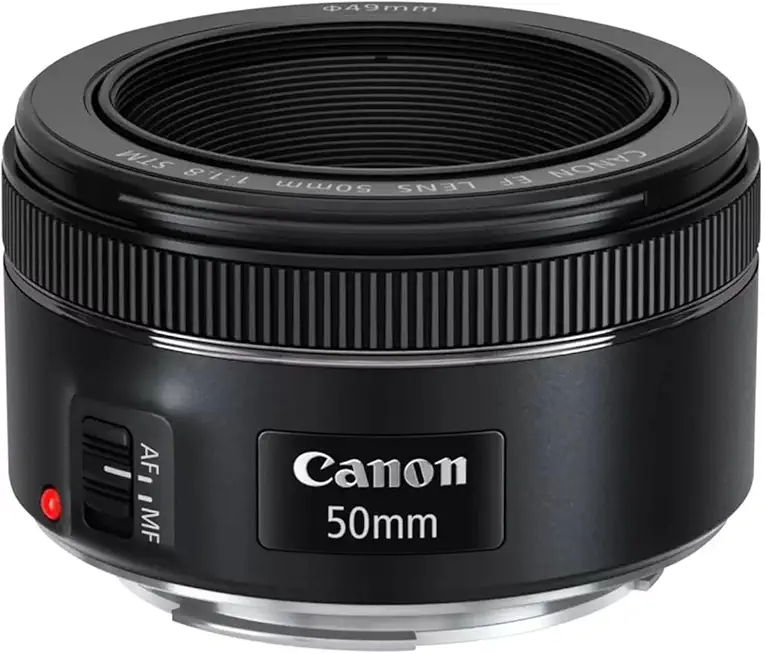

Canon EF 50 mm f/1.8
Affordable, iconic standard prime delivering punchy image quality, reliable autofocus, and a pocketable design—favored by beginners and professionals alike for natural portraits, low-light shooting, and expressive shallow-depth images.
Check PriceI’ve used the EF 50mm f/1.8 a lot over the years and it’s the classic “nifty fifty” for a reason: it’s dirt cheap, very light, and gives pleasing images without much fuss. Compared to the RF f/1.8 it feels slightly older in design and if you mount it on an R body you’ll need an adapter, which adds a bit of bulk and can make AF a touch less snappy. Still, the look it gives—crisp centers and natural colors—is very familiar and very usable.
Where it beats the RF f/1.8 is price and simplicity. If you want a fast 50 on a tight budget, or you already have EF glass, this is a great option. Where it loses out is build and some optical faults wide open: it can show more corner softness and some CA, and on modern R bodies you miss a native control ring and the tiny size advantage the RF version has.
Who will pick this one? Beginners, students, or anyone who wants great results for next-to-no money, and shooters who already own EF glass and don’t mind using an adapter. It’s also a good back-up lens that you won’t mind throwing in a bag for travel.
Alternative 2:
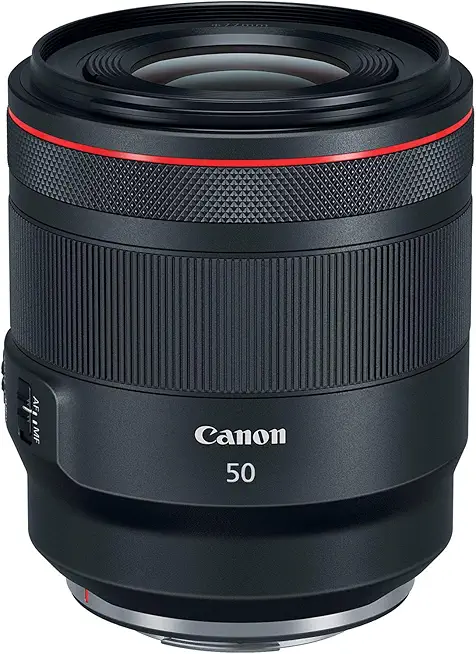

Canon RF 50 mm f/1.2 L
Flagship, ultra-fast standard prime engineered for pro work: outstanding subject isolation, exquisite bokeh, extraordinary sharpness across the frame, durable weather sealing, and refined manual control for editorial and commercial assignments.
Check PriceStepping up to the RF 50mm f/1.2 L is like moving from a compact car to a luxury sedan. I’ve shot weddings and studio work with the 1.2 and the difference in subject separation and bokeh is obvious: backgrounds melt away in a way the f/1.8 cannot match. The build quality and weather sealing also mean I’m not afraid to use it in tougher conditions—something the little RF f/1.8 won’t handle as well.
What it does better than the RF f/1.8 is image look and control: better corner sharpness when shot wide open, smoother out-of-focus rendering, and stronger micro-contrast that makes portraits look more three-dimensional. The trade-offs are size, weight and cost—it’s big, heavy and expensive, so it’s not the lens you reach for when you want to travel light or stay discreet on the street.
Photographers who prefer this one are pros and serious enthusiasts: wedding photographers, commercial shooters, and portrait artists who need the best subject isolation and edge-to-edge performance. If you want a dramatic, creamy look and can carry the extra weight (and budget), this is the lens that delivers it.
Alternative 3:
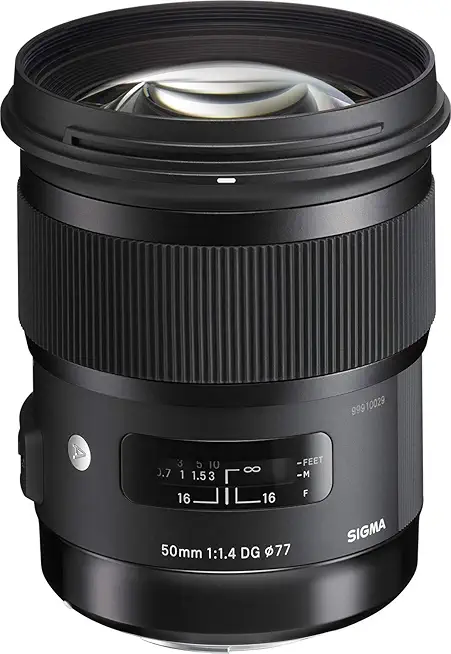

Sigma Canon EF 50 mm f/1.4 Art
High-performance premium prime optimized for modern sensors: delivers exceptional edge-to-edge sharpness, rich contrast, creamy bokeh, precise focusing, and a robust build—ideal for studio, street, and critical portrait work.
Check PriceThe Sigma 50mm f/1.4 Art sits between the two Canon options in my kit: it’s not as heavy or pricey as the RF 1.2, but it punches well above the RF 1.8 in pure image quality. I’ve used it for portraits and editorial work and found its edge-to-edge sharpness and contrast very pleasing. On an R body you’ll use an adapter, and that does add a bit of bulk, but optically it gives a richer, more refined look than the RF f/1.8.
Compared to the RF f/1.8 the Sigma gives shallower depth of field than f/1.8 and cleaner detail across the frame. Compared to the RF 1.2 it won’t give quite the same ultra-creamy bokeh or the same level of weather sealing and native integration, but it’s smaller and significantly cheaper while still delivering pro-grade results. One real-world note: AF can be very precise, but depending on the adapter and body combo you may see slight differences in speed or behavior versus native RF glass.
Choose the Sigma if you want top-tier image quality without paying L-series prices, and if you don’t mind the slight hassle of adapting EF glass to an RF body. It’s a favorite for studio portrait shooters, street photographers who want a richer look, and anyone who values sharpness and build for a mid-range budget.
What People Ask Most
What cameras is the Canon RF 50mm F1.8 STM compatible with?
It’s an RF-mount lens designed for Canon EOS R series mirrorless cameras and works on both full-frame and APS-C RF bodies.
Does the Canon RF 50mm F1.8 STM have image stabilization?
No — it has no in-lens IS and relies on IBIS in compatible Canon bodies for stabilization (supports up to 7 stops compensation).
How sharp is the Canon RF 50mm F1.8 STM at wide apertures?
Center sharpness is very good at f/1.8, but corners are noticeably softer wide open and improve when stopped down toward f/4–f/8.
Does this lens have weather sealing?
No, the lens does not have weather sealing or a mount gasket.
Is the autofocus on the RF 50mm F1.8 STM good for video?
Yes — the STM motor is fast, accurate and near-silent with minimal focus breathing, making it well suited for video.
What is the minimum focusing distance of this lens?
The minimum focus distance is 0.30 m (0.98 ft) with a maximum magnification of about 0.25x.
Does the Canon RF 50mm F1.8 STM come with a lens hood included?
No, a lens hood is not included; the ES-65B hood is sold separately.
Who This Lens Is / Isn’t For
If you’re after an inexpensive, lightweight 50mm for portraits, street, travel, or daily snapshots, this lens will make a lot of sense and be easy to carry everywhere. Photographers who shoot hybrid photo and video will like the quiet autofocus and smooth manual focus feel, while people who rely on a camera with in-body stabilization will find this lens useful for low-light work and creative close-up framing. I’ve seen beginners to experienced hobbyists appreciate the pleasing background blur and strong center sharpness for headshots and social media work, making this lens a practical, no-frills everyday option.
Skip this lens if you need rugged weather sealing, in-lens stabilization, or the absolute best corner performance wide open, because this lens shows vignetting and chromatic issues at the widest apertures. Sports and fast-action shooters should look elsewhere for faster tracking and stabilization, and professionals who shoot in rough conditions or demand pro-level corner-to-corner sharpness will likely outgrow this lens. If you want a single premium optic for every situation, it’s better to spend more or choose a lens with weather sealing and in-lens stabilization.
Should You Buy It?
The Canon RF 50 mm f/1.8 is the little prime that does a lot for the money. It’s compact, easy to carry and surprisingly capable for portraits and hybrid video work.
In the field this lens delivers pleasing bokeh, reliable center sharpness and whisper-quiet autofocus that keeps subjects and footage looking good. The customizable control ring and featherweight handling make it a joy on small mirrorless bodies. For most everyday shooters the output punches above its price.
That said, this lens has clear limits. Wide-open corner softness, visible vignetting and chromatic fringing demand careful shooting or stopping down. The lack of weather sealing and an included hood reduce confidence for heavy-use pros.
Video shooters will appreciate the near-silent AF and smooth manual-focus feel, which keep clips clean and distraction-free. Relying on camera stabilization is a fair trade for the savings in size and weight. That compromise makes this lens unusually versatile for hybrid creators.
Bottom line: buy it if you want an inexpensive, portable prime that performs where it matters most. Skip it if you need rugged build, best-in-class corner performance, or in-lens stabilization for demanding pro work. For the majority of portrait, street and hybrid shooters, this lens is an excellent value.



Canon RF 50 mm f/1.8
Compact, lightweight standard prime offering bright low-light capability, sharp center resolution, and pleasant subject separation—perfect for everyday portraits, street photography, and travel with intuitive handling and fast autofocus.
Check Price


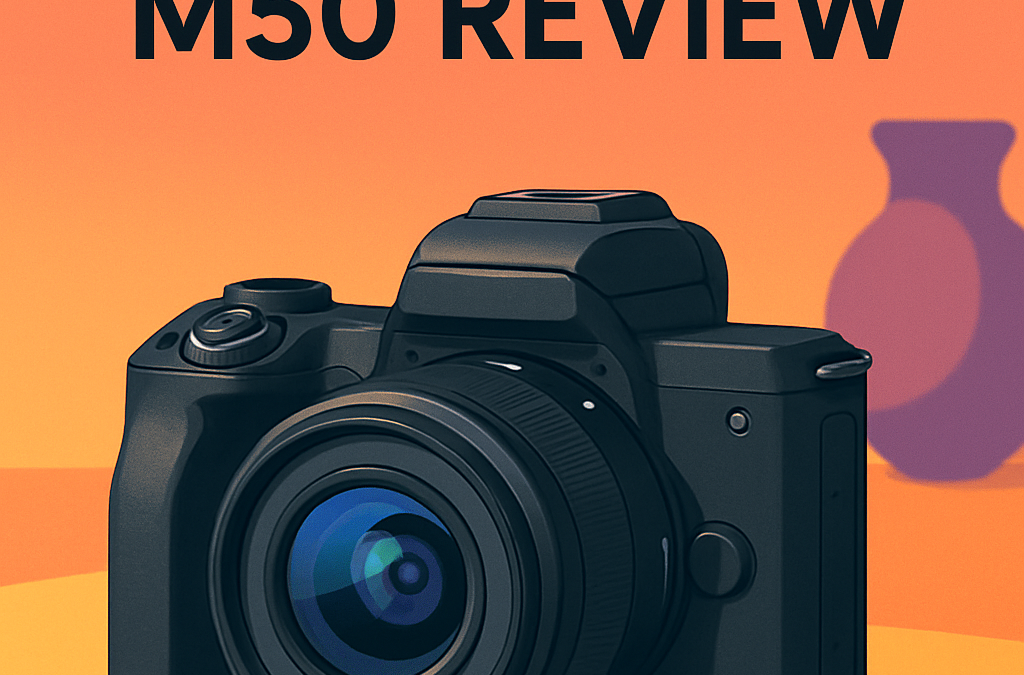

0 Comments